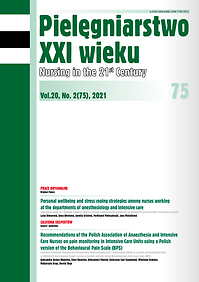Effectiveness of endotracheal intubation among system nurses under simulated conditions - pilot studies
DOI:
https://doi.org/10.2478/pielxxiw-2021-0017Keywords:
nurse, quality of care, endotracheal intubation, simulationAbstract
EFFECTIVENESS OF ENDOTRACHEAL INTUBATION AMONG SYSTEM NURSES UNDER SIMULATED CONDITIONS - PILOT STUDIES
Introduction. Endotracheal intubation (ETI) may be a procedure necessary to perform by a nurse in the event of sudden cardiac arrest (SCA). Its correct execution improves the course and organization of a rescue operation and contributes to increased self-confidence in stressful situations.
Aim. Assessment of the effectiveness of endotracheal intubation among system nurses under simulated conditions.
Material and methods. A pilot study of prospective observational simulation study using advanced evaluation tools for intubation phantom (BT-CSIE, Q'ty model) with a tablet (PC-1EA), IntuBrite laryngoscope with curved handle. The results were analyzed with Statistica PL 12.0 and Microsoft Office Excel 2016, using the Student's t and chi-square tests.
Results. Nurses with specialization intubated twice faster (30.4 s) than nurses during specialization (68.8 s) or without specialization (67.5 s). The shortest time of inserting an endotracheal tube demonstrated subjects with over 10 years of work experience (37.0 s). The mean pressure on the incisors during the procedure was 10.9 N. Ventilation with an average tidal volume of 543 cm³ (p=0.024) was in line with the recommendations of the European Rescue Council (ERC).
Conclusions. Work seniority and specialization significantly affected the effectiveness of the intubation procedure in time, while maintaining the recommended frequency and volume of mechanical ventilations.
References
1. Aleksandrowicz D, Gaszyński W, Gaszyński T. Wytyczne dotyczące udrażniania dróg oddechowych w warunkach pozaszpitalnych u chorych po urazach. Guidelines for clearing the airways in out of hospital settings in trauma patients. Anestezjologia i Ratownictwo. 2013; 7: 233-243.
2. The Act on the State Emergency Medical Services of September 8, 2006. Art. 3 point 6 (Journal of Laws No. 191, item 14100 and of 2007 No. 89, item 59025). Regulation of the Minister of Health of February 28, 2017 on the type and scope of preventive, diagnostic, therapeutic and rehabilitation services provided by a nurse or a midwife without a medical order (Journal of Laws of 2016, items 1251, 1579 and 2020).
3. The Act on the Professions of Nurse and Midwife Art. 6 of July 15, 2011.
4. Regulation of the Minister of Health of February 28, 2017 on the type and scope of preventive, diagnostic, therapeutic and rehabilitation services provided by a nurse or a midwife without a medical order.
5. Anders J, (ed.) Wytyczne resuscytacji. Resuscitation guidelines. Polska Rada Resuscytacji, 2015.
6. Padilha JM, Machado PP, Ribeiro AJ, et al. Clinical Virtual Simulation in Nursing Education. Clinical Simulation in Nursing. 2018; 15: 13-18.
7. Mariani B, Doolen J. Nursing Simulation Research: What Are the Perceived Gaps. Clinical Simulation in Nursing. 2016; 12: 30-36. doi: 10.1016/j.ecns.2015.11.004.
8. Rutherford-Hemming T, Alfes CM. The use of hospital – based simulation in nursing education – a systematic review. Clinical Simulation in Nursing. 2017; 13: 78-89. doi: 10.1016/j.ecns.2016.12.007.
9. Akihisa Y, Maruyama K, Koyama Y, et al. Comparison of intubation performance between the King Vision and Macintosh laryngoscopes in novice personnel: a randomized, crossover manikin study. Journal of Anesthesia. 2014; 28: 51-57. doi: 10.1007/s00540-013-1666-9.
10. Hung YCh, Tan PH, Lin VChH, et al. A comparison of the Trachway intubating stylet and the Macintosh laryngoscope in tracheal intubation: a manikin study. Jorunal of Anesthesia. 2013; 27: 205-210. doi: 10.1016/j.tcmj.2016.06.004.
11. Aleksandrowicz S, Szarpak Ł. A comparison of GlideScope and Macintosh laryngoscopes for endotracheal intubation performed by nurse. American Journal of Emergency Medicine. 2016; 34: 2029-2049. doi: 10.1016/j.ajem.2016.07.047.
12. Saeedi M, Hajiseyedjavadi H, Seyedhosseini J, et al. Comparison of endotracheal intubation, combitube, and laryngeal mask airway between inexperienced and experienced emergency medical staff: A manikin study. International Journal of Critical Illness and Injury Science. 2014; 4: 4. doi: 10.4103/2229-5151.147533.
13. Miki T, Inagawa G, Kikuchi T, et al. Evaluation of the Airway Scope, a new video laryngoscope, in tracheal intubation by naive operators: a manikin study. Acta Anaesthesiol Scand. 2007; 51: 1378-1381. doi: 10.1111/j.1399-6576.2007.01450.x.
14. Aleksandrowicz S, Szarpak Ł. A comparison of GlideScope and Macintosh laryngoscopes for endotracheal intubation performed by nurse. American Journal of Emergency Medicine. 2016; 34: 2029-2049.
15. Choi HY, Oh YM, Kang GH, et al. A Randomized Comparison Simulating Face to Face Endotracheal Intubation of Pentax Airway Scope, C-MAC Video Laryngoscope, Glidescope Video Laryngoscope, and Macintosh Laryngoscope. BioMed Research International. 2015; 7. doi: 10.1155/2015/961782.
Downloads
Published
Issue
Section
License
Copyright (c) 2021 Authors

This work is licensed under a Creative Commons Attribution-NonCommercial-NoDerivatives 4.0 International License.




